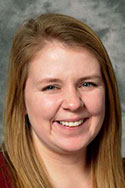The Heart of Hospice: Understanding the Importance to End-of-Life Care
by Hannah Drazenovich
June 2021
Modern medicine has many specialized teams providing care that saves and prolongs patient lives: oncology teams for cancer, cardiovascular teams for heart problems, and neurology teams for dementia problems. Sometimes these teams are unable to cure a patient's illness or condition. At other times, a patient decides to no longer pursue treatment offered by these teams. Those are difficult decisions and patients do not need to make them on their own. That is where another team can be called in to help. Hospice is a team of healthcare providers who specialize in managing symptoms when curative treatment is no longer desired by the patient.
Hospice care focuses on whole person care, an approach that includes helping each patient determine goals and priorities. When death seems near, the hospice team's role is to help patients achieve their goals in the time remaining. Goals can be anything including to stay at home for as long as possible. While in hospice, the patient may elect to focus on comfort and have bothersome symptoms eased as much as possible, while treatments aimed at prolonging life are stopped. Frequently treated symptoms include severe cough, difficulty breathing, uncontrolled diarrhea, nausea, and especially pain. Other conditions that can be addressed while enrolled in hospice include worry, fear, depression, and sadness.
Hospice also helps to prepare and guide a patient's family and loved ones through the dying process, including the steps that follow the passing of a loved one. Continued support in the form of grief counseling is offered to family and friends.
The hospice team is made up of doctors, nurses, social workers, chaplains, and others, like personal care aides. These team members come to the home on a regular basis and can be contacted 24/7 during times of need. Medication for symptom control and pain relief, medical equipment like wheelchairs, bandages for chronic wounds, catheters, and oxygen are brought to the patient's home setting, saving family members from taking off work to locate, purchase, and deliver these items. It's also important for patients and family members to know that Medicare, Medicaid, and most private insurance plans cover these hospice services.
One myth about hospice care is that patients who enroll only have several weeks to live. This idea often prevents patients and their families from asking their doctors about these services. In reality, patients get the most benefit from hospice services when they are started six months in advance of the time when medical providers believe that death seems most likely. Under hospice, the focus is on care coming to the patient rather than the patient needing to go to the care. Care is provided wherever “home” is for the patient, such as the patient's private residence, nursing home, or assisted living facility.
Another myth about hospice is once a patient enrolls, they can't sign off. The hospice benefit is flexible. There are instances when a patient's terminal illness improves or someone decides to seek curative treatment. If this happens, patients can always choose to withdraw from hospice care and can re-enroll at any future time if desired. Once again, the goal of hospice is to ensure the wishes of the patient are met and wishes change from time to time.
Admittedly, the time of death is always unpredictable. Because of this, the discussion around death seems more natural to avoid than attempting any discussion at all. But with the presence of certain medical conditions — cancer, dementia, heart disease, and stroke — dying is more predictable. Being familiar with hospice care that focuses on comfort, dignity, and whole patient care can make a difference for both patients and families.
This article also appeared in the June 30, 2021 issue of the Jamestown Sun.
About the Author
 Hannah Drazenovich is a
third-year medical student at the University of North
Dakota School of Medicine & Health Sciences. She was
selected as the Jamestown participant for the school's
ROME program, or Rural Opportunities in Medical
Education. The program includes teaching student doctors
the importance of rural newspapers. As a future rural
healthcare leader, Drazenovich has written this column to
provide health information for her ROME community. The
information is not for diagnosis or treatment and should
not be used in place of previous medical advice provided
by a licensed practitioner.
Hannah Drazenovich is a
third-year medical student at the University of North
Dakota School of Medicine & Health Sciences. She was
selected as the Jamestown participant for the school's
ROME program, or Rural Opportunities in Medical
Education. The program includes teaching student doctors
the importance of rural newspapers. As a future rural
healthcare leader, Drazenovich has written this column to
provide health information for her ROME community. The
information is not for diagnosis or treatment and should
not be used in place of previous medical advice provided
by a licensed practitioner.
